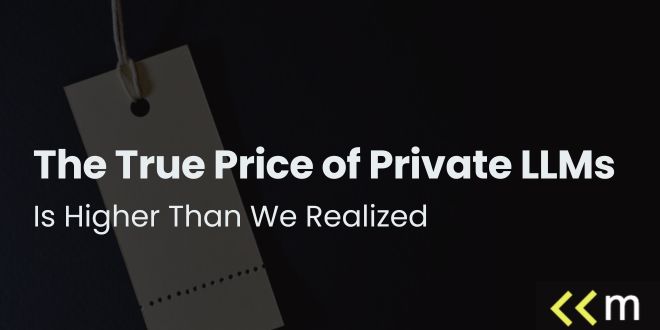The True Price of Private LLMs Is Higher Than We Realized

Spinning up your own Large Language Model sounds like a badge of honor: complete control, corporate secrecy preserved, and bragging rights at the next tech meetup. Yet once the champagne fizzles, many teams discover that the real price tag is less “discount cloud invoice” and more “surprise luxury yacht”—only you never asked for the yacht, and you definitely have to fuel it. Let’s pull back the velvet curtain and see where the money actually goes.
Example Scenarios (for illustration)
- A small company that uses an LLM for internal Q&A with maybe 1 M tokens/month, could go with cloud API: low initial cost, maybe ~$20k setup + ~$50k/year usage.
- A large regulated enterprise (finance, healthcare) that needs strict data control, handling maybe tens of millions of tokens/month, might opt for on-prem: maybe ~$500k initial hardware/installation + ~$300k/year in power, staff, compliance.
- A mid-sized company handles sensitive data for maybe 2–5 M monthly tokens, uses hybrid: maybe ~$200k initial + ~$150k/year ongoing.
Why Private LLMs Feel Like a Bargain at First
Hardware Hiccups and Hidden Bills
First, there’s the hardware honeymoon. A slick slide deck says one cluster will do. Then someone notices that peak inference loads spike on Mondays and half of Thursday. Suddenly, you need three clusters, not one. The GPUs themselves might depreciate faster than a toddler outgrows sneakers, but the bigger shock is the auxiliary gear: fortified racks, redundant power, industrial-grade cooling, and yes, the server room now resembles a small arctic biome. Every extra fan shrugs at your budget.
The Data Diet No One Budgeted For
Private models need training data—tons of it. Legal tells you to dodge copyrighted text, marketing wants branded chat logs scrubbed, and engineering longs for diverse code snippets. Buying premium datasets or licensing niche corpora chips away at funds, but preprocessing eats even more. Staff spend weeks deduplicating, tokenizing, and politely wrestling with encoding gremlins. All that overtime? Also on your tab.
Engineering Costs That Sneak Up on the Ledger
Staffing a Team of Unicorns
Fine-tuning an LLM is glamorous until you realize “AI engineer” is shorthand for five roles: data wrangler, distributed-system whisperer, optimization guru, prompt alchemist, and reluctant SRE. Hiring even two of those people is pricey. Retaining them is pricier. Offer enough perks and they stay—offer too few and they moonwalk to a hyperscaler whose cafeteria has a pizza robot.
Maintenance Is Eternal
Models drift like sailboats without a rudder. New slang hits social media, compliance rules shift, and suddenly your once-sharp chat assistant is quoting last year’s statistics while hallucinating new abbreviations. Continuous fine-tuning, evaluation, and patching define an endless treadmill. Skip a sprint and watch performance sag, user complaints rise, and CFO eyebrows lift.
The Compliance and Risk Tab
Legal Fees and Audit Fatigue
Privacy laws multiply like mogwai after midnight. Each regulation adds disclaimers, audits, and mandatory training. Lawyers bill by the hour. Auditors bill by the scope. Your ops team files paper trails so thick they need shelf reinforcement. The model may be private, but verifying that it is lawful across every jurisdiction costs as much as a midsize sedan—every quarter.
Security Anxiety and Insurance Spikes
A private deployment means you guard the crown jewels yourself. Pen-testing, intrusion detection, and incident response drills become routine. Cyber-insurance premiums leap because underwriters know that a breach revealing chat transcripts could light social media on fire. Anxious board members then ask for extra coverage, and the cycle repeats.
Opportunity Cost: What You Cannot Build While Babysitting an LLM
Feature Roadmaps on Pause
Product managers dream of dashboards, mobile apps, and flashy widgets. Yet the engineering calendar turns into a permanent “model ops” block. Time spent tweaking tensors is time not spent shipping revenue-generating features. Stakeholders may clap at demo day, but customers still wait for the button you promised six months ago.
Innovation Debt in the Making
When teams babysit a model, exploratory R&D stalls. Your brightest minds chase deltas in perplexity rather than breakthroughs in user experience. Over quarters, the company’s creative edge dulls. Competitors who rent models skip the upkeep and instead launch the next viral tool while your devs nurse GPU temperature charts.
When to Rent Instead of Own
Cloud-Hosted Alternatives
Leasing compute from providers offers elasticity without forklift-level hardware costs. Sure, pay-as-you-go fees look steep, yet you dodge capital expenditure, cooling upgrades, and 3 a.m. pager duty. Plus, leading vendors patch vulnerabilities before breakfast, saving your ops team an ulcer or two.
Hybrid Approaches
Some firms split the difference: sensitive prompts stay on a slim in-house model, while bulk traffic runs on a shared service. This setup trims risk and spend, though orchestration complexity rises. Still, complexity is often cheaper than a warehouse of idling silicon.
Conclusion
Private LLMs radiate allure, but their ledger lines multiply faster than an optimistic spreadsheet can scroll. From hidden hardware demand to legal labyrinths and opportunity costs, ownership can drain more than it dazzles. Before buying pallets of GPUs, weigh not just the sticker price, but the marathon of upkeep, talent, and risk that follows. Otherwise, you may find that your “bargain” AI strategy is really a luxury yacht you never meant to captain—complete with crew salaries and endless fuel stops.
Notes & Caveats
Samuel Edwards is an accomplished marketing leader serving as Chief Marketing Officer at LLM.co. With over nine years of experience as a digital marketing strategist and CMO, he brings deep expertise in organic and paid search marketing, data analytics, brand strategy, and performance-driven campaigns. At LLM.co, Samuel oversees all facets of marketing—including brand strategy, demand generation, digital advertising, SEO, content, and public relations. He builds and leads cross-functional teams to align product positioning with market demand, ensuring clear messaging and growth within AI-driven language model solutions. His approach combines technical rigor with creative storytelling to cultivate brand trust and accelerate pipeline velocity.







